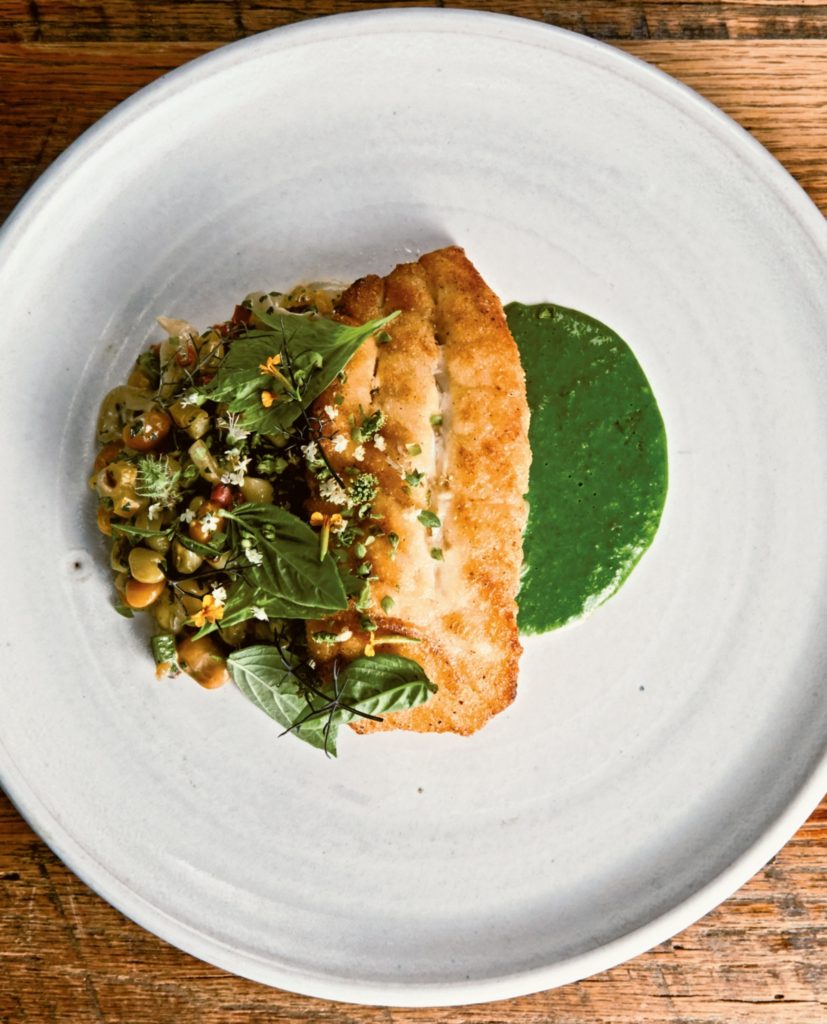Sean Brock (author of Heritage and the newly released South) is, undoubtedly, an important figure in the American culinary landscape. Writers like Edna Lewis, James Villas, Craig Claiborne and Ronni Lundy have covered similar ground, singing the praises of the homespun cooking of the American south, but that was before the era of the tattooed, rockstar chef and the advent of locavorism as a driving force in the restaurant industry.
The farm-to-table movement is probably the biggest trend to emerge in North American culinary scene in the last quarter century and it has proven to be remarkably durable. Alice Waters, who opened Chez Panisse in Berkley California in 1971, is the acknowledged founder of the movement and her influence continues to reverberate, with chefs honing their focus on local, seasonal ingredients, and the cooking methods – conventional to molecular — that enhance their innate qualities and flavour.
In some parts of rural America, farm-to-table is nothing new. It is the way people whose access to ingredients is limited – whether by geography, season, economic constraints or a mix of all three — have cooked for generations. But as modern chefs have pushed the technical boundaries of their profession and urban palates have become more sophisticated, country cooking is often seen as homespun and lacking in refinement.
Sean Brock set out to change all that, using only ingredients from the South in his acclaimed restaurants Husk and McGradys in Charleston in Nashville. The chef has been a James Beard Award finalist seven times, and took home the award for Best Chef Southeast in 2010.
In his latest book, and the new restaurant he is planning to open in Nashville, the focus is tightened to the cuisine of Appalachia, the region where he grew up, learning to cook at his grandmother’s side. He writes:
“The kitchen was always buzzing at my grandmother’s home in Pound, Virginia. There was rarely a time when some sort of food preparation wasn’t going on. If you were watching television, you were snapping beans. If you were porch sitting, you were shucking corn or grating cabbage.”
The majority of recipes in South are for classic dishes – shrimp and grits, fried green tomatoes, fried chicken, catfish, slow-cooked greens, cornbread, biscuits and the like – that are cooked throughout the South and can be found in any number of cookbooks. But interpreted by Brock, whose laser-tight focus and obsessive attention to detail are legendary in cheffing circles, these standards are elevated to new levels of sophistication and taste.
One reason why I chose this book to review was because I was working in Florida at the time and knew I would have access to at least some of the ingredients Brock’s hyper-local recipes call for. Brock provides a list of his favourite artisan food producers in the back of the book but since his premise is to cook with what is native to your region, resorting to mail order seems counter-intuitive. Instead, I concentrated on recipes using ingredients I could find within a 20-mile radius of my lodging.
White Lily flour, country ham and andouille sausage were available in my local supermarket. A farmers’ market yielded pastured beef, turnips with their greens, farm eggs, green tomatoes and sweet potatoes. A seafood market on the coast offered shrimp, crabs, oysters, grouper and catfish. I couldn’t locate Brock’s recommended Anson Mills grits but Dixie Ice Cream Yellow Speckled Grits stone ground by Nora Mill Granary (established 1876) “located in the historic district of Sautee-Nacoochee Valley, 1 mile south of Helen, Georgia” seemed like a pedigree Brock would approve of. Nowhere could I find sorghum syrup or fresh lard, which disqualified a bunch of recipes.
Many recipes in South are pretty basic, but have a twist that lifts them up. Cornmeal-dusted grouper is simply dredged in fine cornmeal and pan fried – but it is brought to life with a zesty, brilliantly green herb puree. Strip steak cooked over charcoal is rested in “love sauce” (a concoction of Worcestershire, fish sauce and garlic) that adds an intriguing complexity to the steak. There are recipes throughout the book for preserves, pickles, ferments and condiments that demonstrate Brock’s knack for refining –redefining even — a rustic cuisine using its own ingredients and techniques.

In Brock’s hands, humble vegetables come to life. Sweet potatoes, baked and blended until smooth with milk and vegetable stock, are brightened with fresh orange juice. Adding a dash of soy sauce to mushrooms cooked on the charcoal grill amps up their natural umami. Turnips I cooked several ways – charring them on the grill (the little globes were crisp and slightly blackened on the outside and toothsomely tender within) and cooking their greens directly on the coals. Others I braised in butter, stock and vinegar, a technique Brock says can also be used for carrots, butternut squash or onions. Finally I followed the instructions in an essay titled “How to Cook a Pot of Greens” to use up the leftover turnip tops, with delicious results.

The biggest revelation came in Brock’s recipe for Fried Green Tomatoes, which I love, but which are messy to make and so often disappointing when ordered in a restaurant. As Brock explains:
“The problem with most bad fried green tomatoes is overbreading, which can muffle the character and flavour of the tomatoes.” I hear you!
He dispenses with the messy egg wash and flour breading in favour of a bath in buttermilk and a dusting of cornmeal. The secret to success is to allow the tomatoes to rest in the fridge before frying, so that the breading adheres, instead of falling off in the pan. I was so pleased with the result and amazed at the simplicity of the method that I made a second batch just to be sure it wasn’t a fluke. But, yes, I now have fried green tomatoes DOWN!
I’ve also been making Brock’s buttermilk biscuits by the batch. They’re laminated by folding puff-pastry style and baked in cast iron skillet which promotes a quick fluffy rise and a lovely golden crust. They are so easy to make and so delicious, I now understand why biscuits are a staple of the Southern diet.
The only failure I had during recipe testing was with pressure cooking grits. I followed the instructions, soaking the grits for eight hours and pressure cooking for 15 minutes. When I opened the pot, instead of Dixie Ice Cream, I was faced with a pool of gritty glue and a concrete-like mass stuck to the bottom of the pot.
As a control, I cooked the same grits using Brock’s traditional, stovetop method which involves about an hour of standing by the stove and stirring. The result was a creamy and delicious base for an improvised topping of andouille sausage, tomatoes and bell peppers.
Cooking this way from scratch is time consuming. I had to wash those turnip greens in three changes of water to rid them of sand and grit before cooking. The pretty little turnips each had to be scrubbed, topped and tailed; grits have to be soaked, dry beans hydrated. The reality for most of us is that we don’t have time to cook this way, except on weekends. It’s ironic, and more than little sad, that we go out to restaurants in order to eat as if we had cooked at home.

It remains to be seen if Sean Brock’s impact on the American culinary landscape will be as enduring as Alice Waters’ but following a (well documented) stint in rehab Brock has emerged with an evangelist’s commitment to the pursuit of a wholesome lifestyle, which translates into the type of food he is cooking. These dishes, rooted in the Appalachian foodways of his family, belong to a time and place far removed from rockstar chefdom and workaholic pursuit of perfection. They are dishes designed to renew and celebrate our connection to the land and to the relationships that sustain us.
Ultimately, South is a book for the reader or cook who has more than a passing interest in the culture, cuisine and culinary history of the American south. It goes deep and speaks of spiritual connections – to Europe, West Africa and rural America — that cannot have the same resonance for those of us who are not born of this cultural lineage. But we can learn about resilience and the importance of food and family from Brock’s Appalachian stories, and discover new kinds of deliciousness in recipes that are detailed and clearly written, and in my experience, produce excellent results. Even if you don’t buy a copy of South, do yourself a favour, invest in a cast iron skillet and bake Sean Brock’s biscuits using the recipe included below. Then offer up thanks for this Southern chef’s generous gift.

See all of our cookbook reviews on Pinterest!


